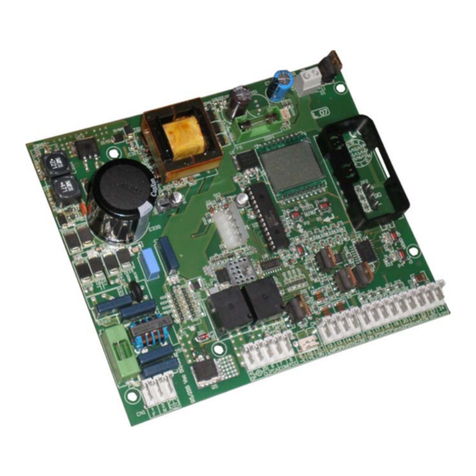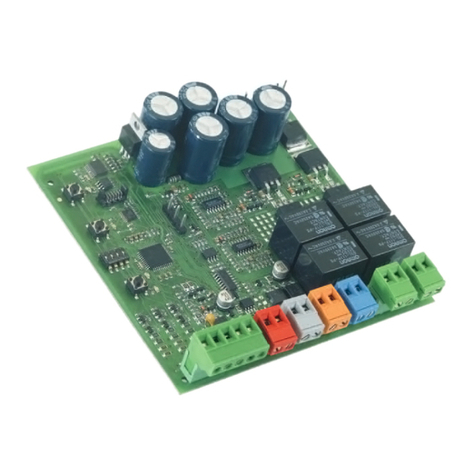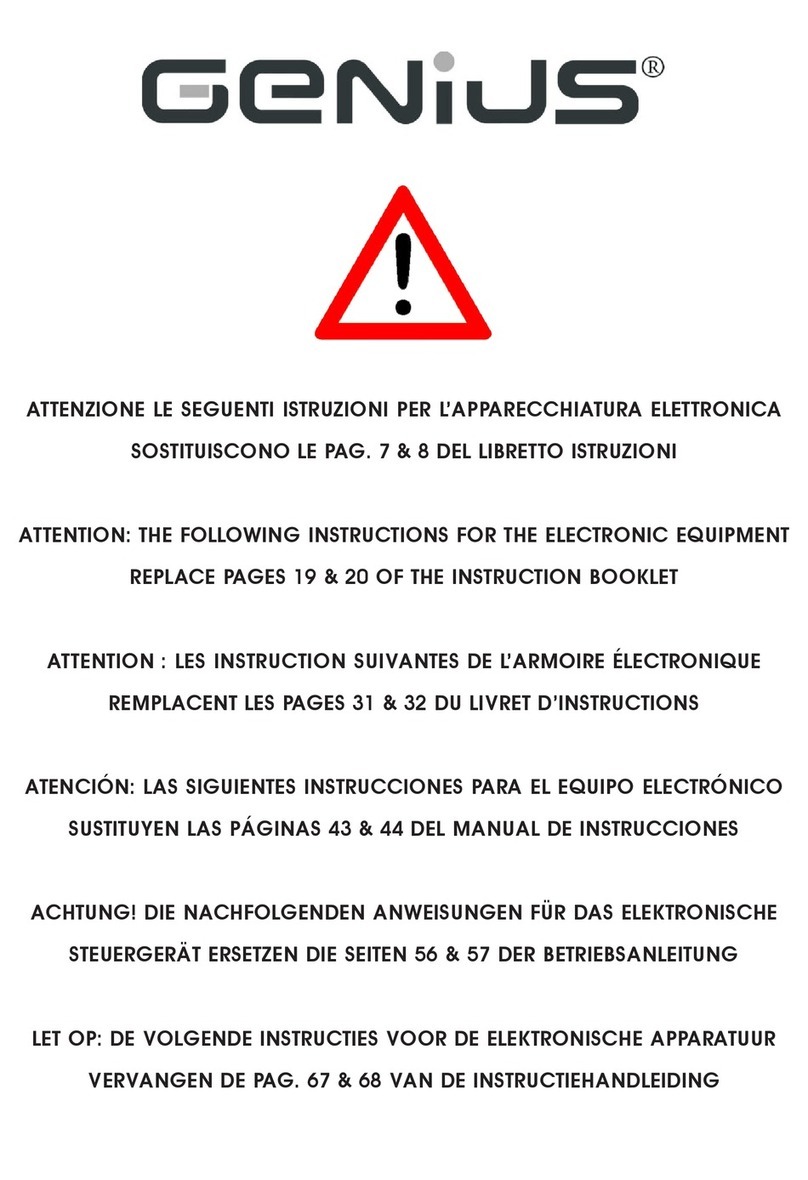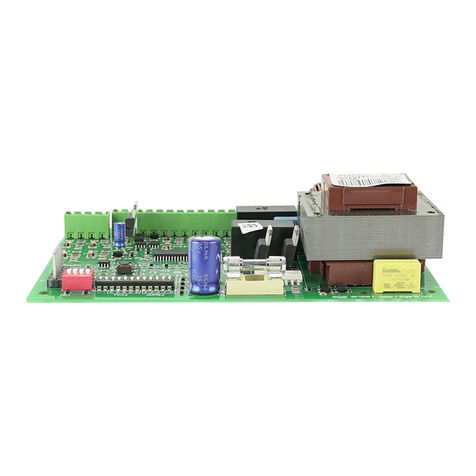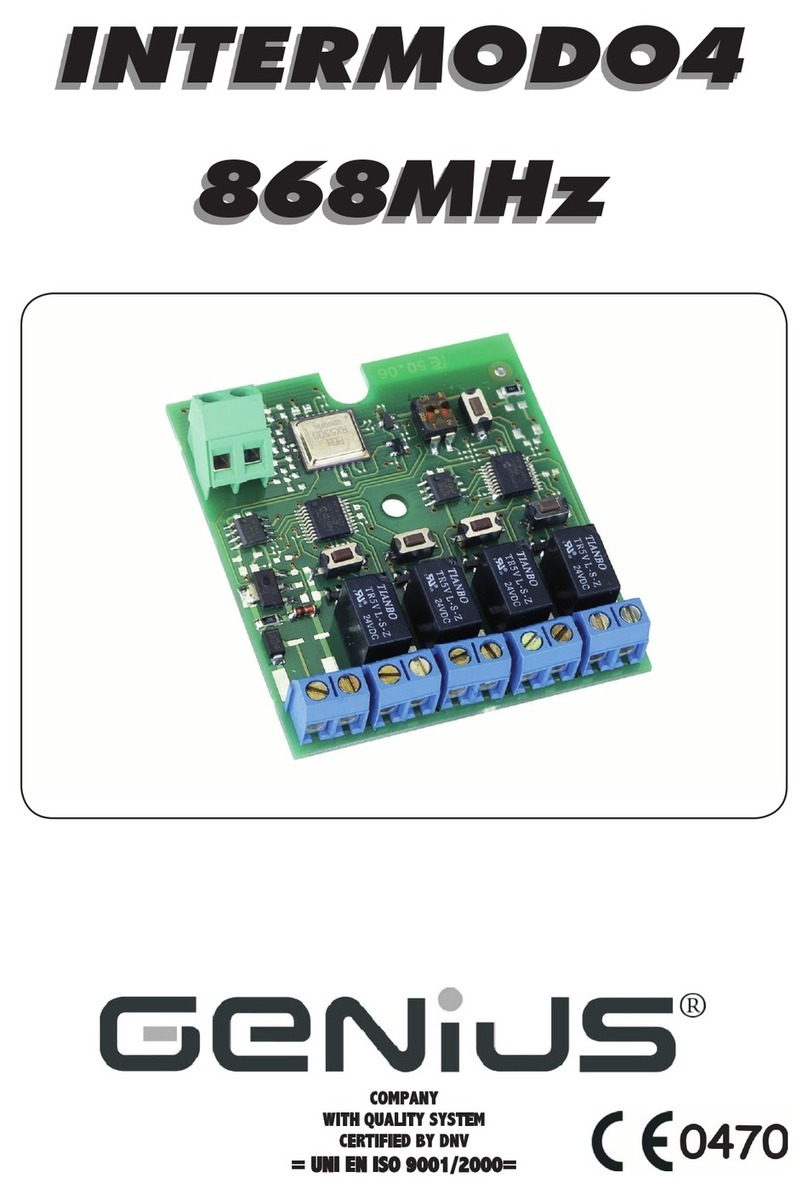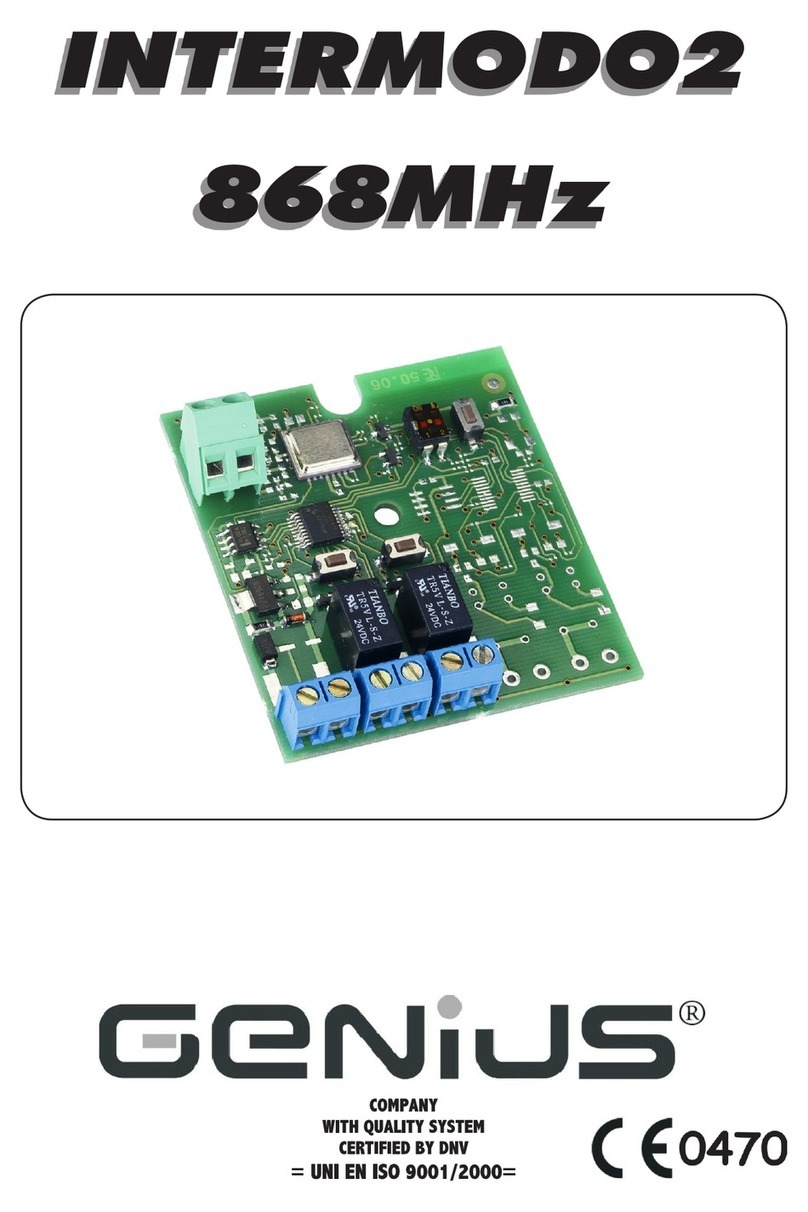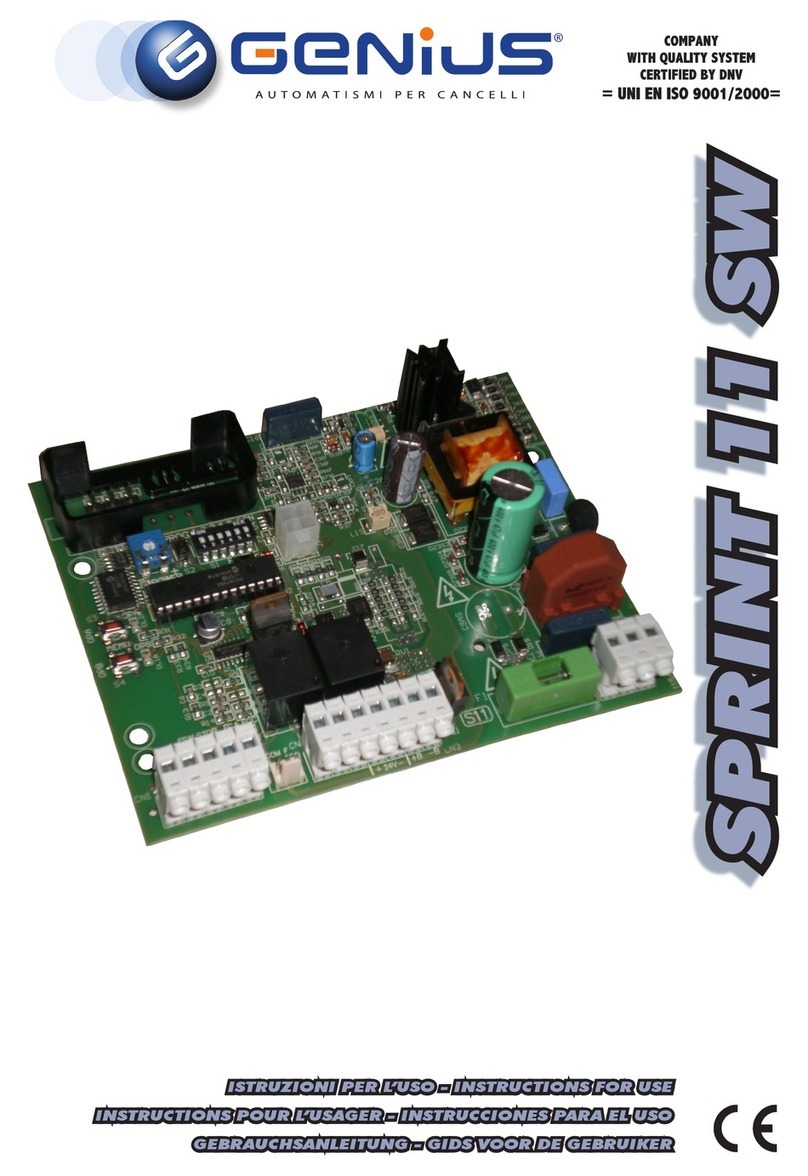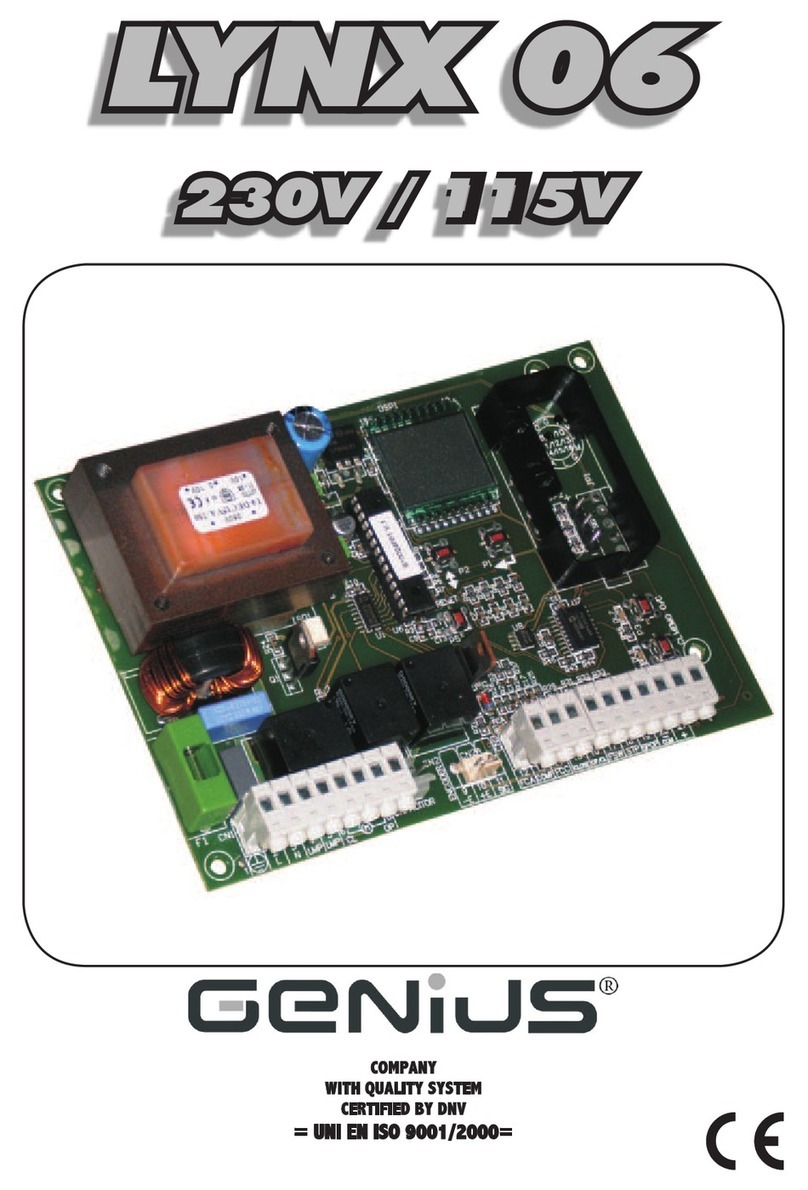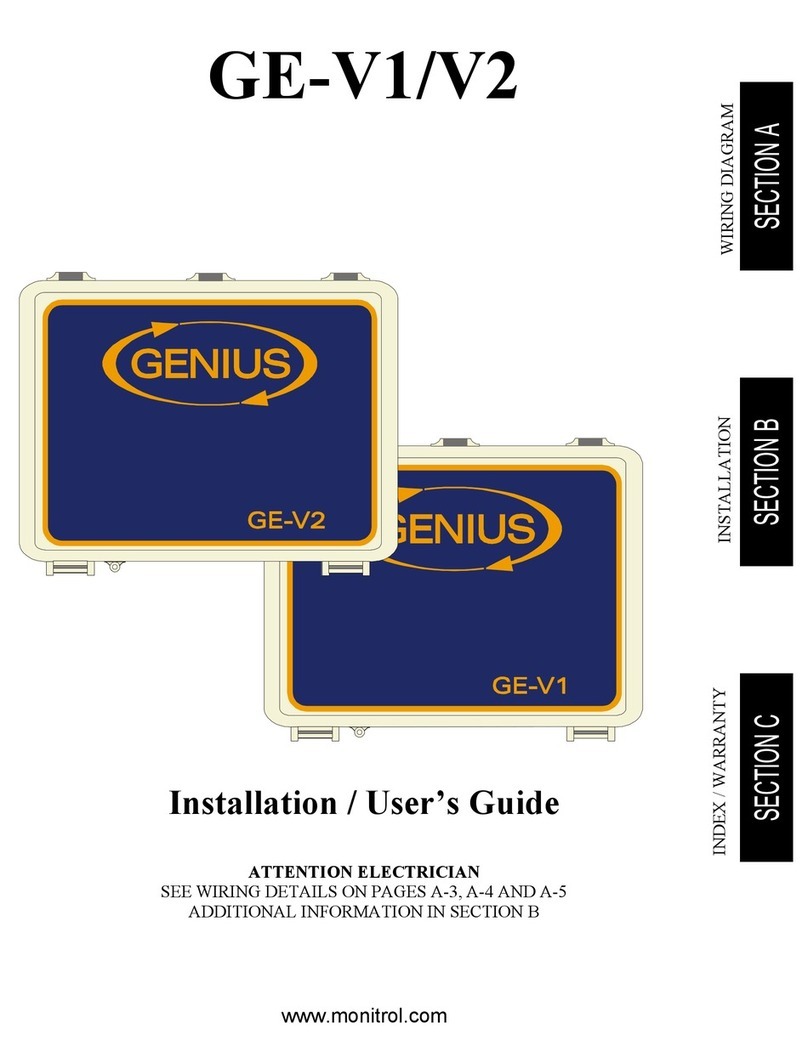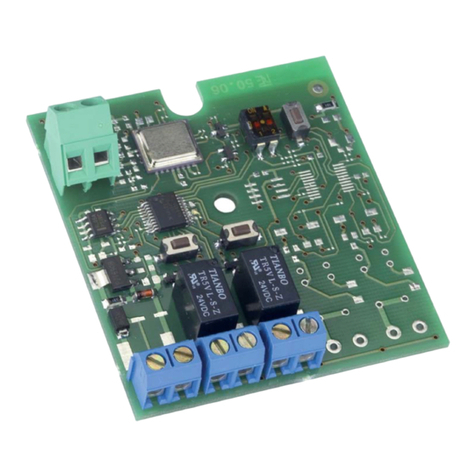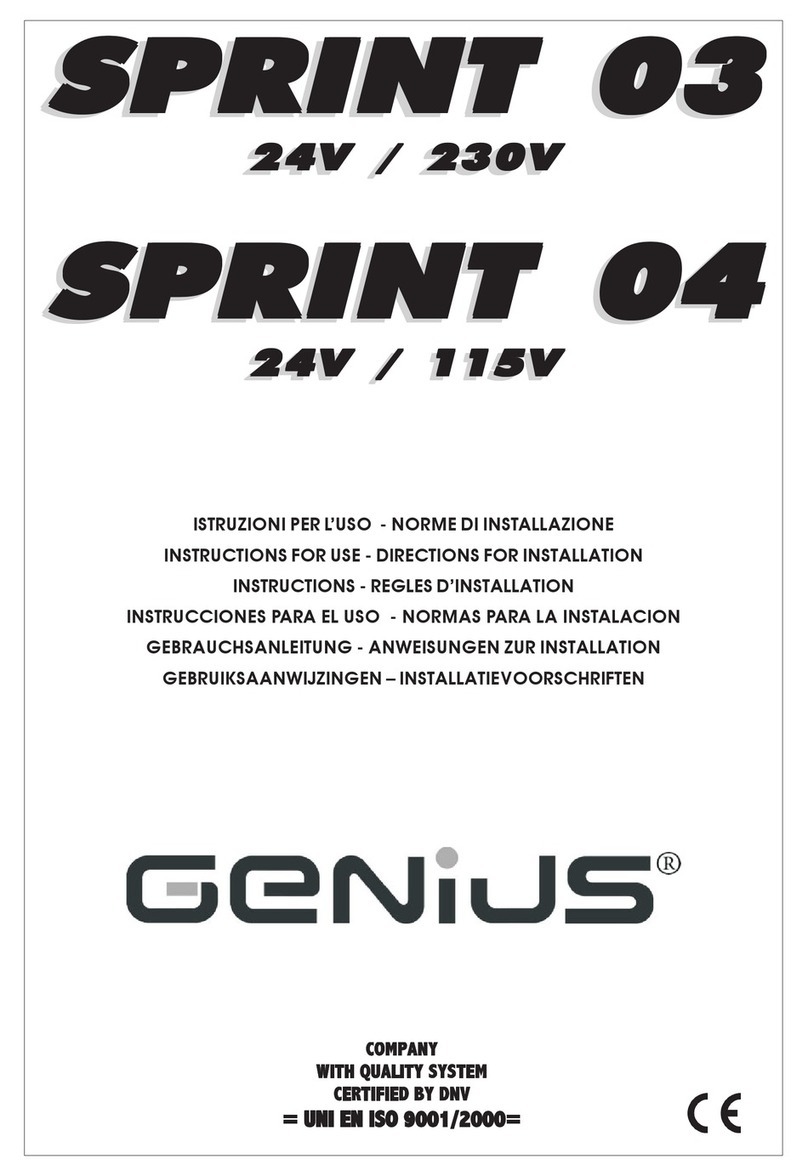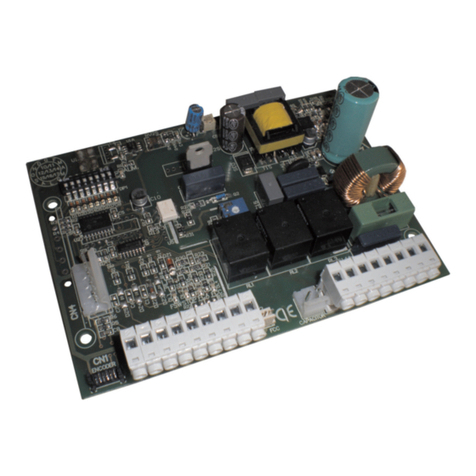AVVERTENZEPERL’INSTALLATORE
OBBLIGHI GENERALI PER LA SICUREZZA
1) ATTENZIONE! È importante per la sicurezza delle persone seguire attenta-
mentetuttal’istruzione.Unaerratainstallazioneounerratousodelprodotto
può portare a gravi danni alle persone.
2) Leggere attentamenteleistruzioniprimadi iniziare l’installazione delprodot-
to.
3) I materiali dell’imballaggio (plastica, polistirolo, ecc.) non devono essere
lasciatiallaportatadeibambiniin quanto potenziali fonti di pericolo.
4) Conservare le istruzioni per riferimenti futuri.
5) Questo prodottoèstatoprogettatoecostruitoesclusivamenteperl’utilizzo
indicatoinquesta documentazione.Qualsiasialtroutilizzo nonespressamen-
teindicato potrebbe pregiudicare l’integrità del prodotto e/o rappresen-
tare fonte di pericolo.
6) GENIUS declinaqualsiasiresponsabilitàderivata dall’uso improprioodiverso
daquellopercuil’automatismoè destinato.
7) Non installarel’apparecchioinatmosfera esplosiva:lapresenzadi gas ofumi
infiammabilicostituisceungravepericoloper la sicurezza.
8) Gli elementi costruttivi meccanici devono essere in accordo con quanto
stabilito dalle Norme EN 12604 e EN 12605.
Peri Paesi extra-CEE, oltre ai riferimenti normativi nazionali, per ottenere un
livellodisicurezzaadeguato,devonoessere seguite le Norme soprariporta-
te.
9) GENIUS nonèresponsabiledell’inosservanzadellaBuonaTecnicanellaco-
struzione delle chiusure da motorizzare, nonché delle deformazioni che
dovesserointervenirenell’utilizzo.
10) L’installazionedeveessereeffettuata nell’osservanza delle Norme EN12453
eEN 12445. Il livello di sicurezza dell’automazione deve essere C+E.
11) Primadieffettuarequalsiasi intervento sull’impianto,toglierel’alimentazione
elettrica.
12) Prevedere sulla rete di alimentazione dell’automazione un interruttore
onnipolarecondistanzad’aperturadeicontatti uguale o superiore a3mm.
Èconsigliabilel’uso diunmagnetotermico da6Aconinterruzione onnipolare.
13) Verificarecheamontedell’impiantovisiauninterruttoredifferenzialecon
sogliada0,03 A.
14) Verificare che l’impianto di terra sia realizzato a regola d’arte e collegarvi
lepartimetallichedellachiusura.
15) L’automazionedisponediunasicurezza intrinseca antischiacciamento co-
stituitadauncontrollo di coppia.E'comunquenecessarioverificarne la sogli
diinterventosecondoquantoprevistodalleNormeindicatealpunto10.
16) I dispositivi di sicurezza (norma EN 12978) permettono di proteggere even-
tuali aree di pericolo da Rischi meccanici di movimento, come ad Es.
schiacciamento,convogliamento,cesoiamento.
17) Perogniimpiantoè consigliato l’utilizzo dialmenounasegnalazionelumino-
sanonchédi un cartellodisegnalazionefissato adeguatamentesullastruttu-
radell’infisso, oltre ai dispositivi citati al punto “16”.
18) GENIUSdeclinaogniresponsabilità ai finidellasicurezzaedel buonfunziona-
mentodell’automazione,in casovenganoutilizzaticomponenti dell’impian-
tonondiproduzioneGENIUS.
19) Perlamanutenzioneutilizzareesclusivamenteparti originali GENIUS.
20) Non eseguire alcuna modifica sui componenti facenti parte del sistema
d’automazione.
21) L’installatore deve fornire tutte le informazioni relative al funzionamento
manuale del sistema in caso di emergenza e consegnare all’Utente
utilizzatoredell’impiantoil libretto d’avvertenze allegato al prodotto.
22) Nonpermettereaibambini o personedisostarenellevicinanze del prodotto
duranteilfunzionamento.
23) Tenerefuoridallaportata dei bambiniradiocomandioqualsiasialtro datore
diimpulso,perevitarechel’automazionepossaessereazionatainvolonta-
riamente.
24) Iltransitotraleante deve avvenire solo a cancello completamenteaperto.
25) L’Utente utilizzatore deve astenersi da qualsiasi tentativo di riparazione o
d’interventodirettoe rivolgersi solo a personale qualificato.
26) Tutto quello che non è previsto espressamente in queste istruzioni non è
permesso
IMPORTANT NOTICE FOR THE INSTALLER
GENERAL SAFETY REGULATIONS
1) ATTENTION! To ensure the safety of people, it is important that you read
all the following instructions. Incorrect installation or incorrect use of the
product could cause serious harm to people.
2) Carefully readtheinstructionsbeforebeginningtoinstalltheproduct.
3) Do not leave packing materials (plastic,polystyrene,etc.) within reachof
childrenas such materials are potential sources of danger.
4) Storetheseinstructionsfor futurereference.
5) This product was designed and built strictly for the use indicated in this
documentation.Anyotheruse, not expresslyindicatedhere,could compro-
mise the good condition/operation of the product and/or be a source of
danger.
6) GENIUS declinesallliabilitycausedbyimproper use or use other thanthatfor
whichtheautomated systemwasintended.
7) Do not install the equipment in an explosive atmosphere: the presence of
inflammablegasorfumesisaseriousdangerto safety.
8) The mechanicalpartsmustconformtotheprovisionsofStandardsEN12604
andEN12605.
For non-EU countries, to obtain an adequate level of safety, the Standards
mentionedabovemustbeobserved,in additiontonational legalregulations.
9) GENIUS is not responsible for failure to observe Good Technique in the
constructionoftheclosingelements to bemotorised,orforanydeformation
thatmayoccurduringuse.
10) Theinstallationmustconform to StandardsEN12453and EN 12445.Thesafety
leveloftheautomatedsystemmust be C+E.
11) Beforeattemptinganyjobonthesystem,cutoutelectricalpower.
12) The mains power supply of the automatedsystemmustbefittedwithanall-
pole switch with contact opening distance of 3mm or greater. Use of a 6A
thermalbreakerwith all-pole circuit break is recommended.
13) Makesurethatadifferential switch with threshold of 0.03 Aisfittedupstream
ofthesystem.
14) Make sure that the earthing system is perfectly constructed, and connect
metal parts of the means of the closure to it.
15) Theautomatedsystemis suppliedwithanintrinsic anti-crushing safetydevice
consisting of a torque control. Nevertheless, its tripping threshold must be
checkedasspecifiedintheStandardsindicatedatpoint10.
16) The safety devices (EN 12978 standard) protect any danger areas against
mechanicalmovementRisks,such as crushing,dragging,andshearing.
17) Useofatleastoneindicator-lightisrecommendedforeverysystem,aswell
asawarningsign adequately secured to the frame structure, in addition to
thedevicesmentionedatpoint“16”.
18) GENIUSdeclinesallliabilityas concerns safety and efficient operationofthe
automatedsystem,if systemcomponentsnotproduced byGENIUSareused.
19) Formaintenance,strictlyuseoriginalparts by GENIUS.
20) Donotinanyway modify the components oftheautomatedsystem.
21) Theinstallershallsupplyall information concerning manual operation of the
systemincase of anemergency,andshall handovertothe user thewarnings
handbooksuppliedwiththe product.
22) Donotallowchildrenoradultstostayneartheproductwhileitisoperating.
23) Keep remote controls or other pulse generators away from children, to
preventtheautomatedsystemfrom being activated involuntarily.
24) Transitthroughtheleavesisallowed only when the gate is fully open.
25) The user must not attempt any kind of repair or direct action whatever and
contactqualifiedpersonnelonly.
26) Anything not expressly specified in these instructions is not permitted.
CONSIGNES POUR L'INSTALLATEUR
RÈGLES DE SÉCURITÉ
1) ATTENTION! Il est important, pour la sécurité des personnes, de suivre à la
lettre toutes les instructions. Une installation erronée ou un usage erroné
du produit peut entraîner de graves conséquences pour les personnes.
2) Lire attentivement les instructions avant d'installer le produit.
3) Les matériauxd'emballage(matièreplastique, polystyrène, etc.)nedoivent
pas être laissés à la portée des enfants car ils constituent des sources
potentiellesdedanger.
4) Conserver lesinstructionspourlesréférencesfutures.
5) Ce produitaétéconçu et construitexclusivementpourl'usageindiqué dans
cette documentation. Toute autre utilisation non expressément indiquée
pourraitcompromettre l'intégrité du produit et/ou représenter une source
dedanger.
6) GENIUS décline toute responsabilité qui dériverait d'usage impropre ou
différentdeceluiauquell'automatismeest destiné.
7) Ne pas installer l'appareil dans une atmosphère explosive: la présence de
gazoudefuméesinflammables constitue un grave dangerpourlasécurité.
8) Les composantsmécaniquesdoivent répondreauxprescriptionsdesNormes
EN 12604 et EN 12605.
PourlesPaysextra-CEE,l'obtentiond'unniveau de sécurité approprié exige
nonseulementlerespect des normesnationales,maiségalementle respect
desNormessusmentionnées.
9) GENIUS n'estpasresponsabledu non-respect delaBonneTechnique dans la
constructiondesfermeturesàmotoriser,nidesdéformationsquipourraient
intervenirlorsde l'utilisation.
10) L'installationdoitêtreeffectuéeconformémentauxNormes EN 12453 et EN
12445.Leniveaudesécuritédel'automatismedoitêtreC+E.
11) Couperl'alimentationélectriqueavanttoute intervention sur l'installation.
12) Prévoir, sur le secteur d'alimentation de l'automatisme, un interrupteur
omnipolaireavecunedistanced'ouverturedescontactségaleousupérieure
à 3 mm. On recommande d'utiliser un magnétothermique de 6A avec
interruptionomnipolaire.
13) Vérifierqu'ilyait,enamontdel'installation,un interrupteur différentiel avec
unseuilde0,03A.
14) Vérifierquelamiseàterreestréaliséeselonlesrèglesdel'artetyconnecter
lespiècesmétalliquesdelafermeture.
15) L'automatismedisposed'unesécuritéintrinsèque anti-écrasement, formée
d'un contrôle du couple. Il est toutefois nécessaire d'en vérifier le seuil
d'interventionsuivantlesprescriptionsdesNormesindiquées au point 10.
16) Les dispositifs de sécurité (norme EN 12978) permettent de protéger des
zones éventuellement dangereuses contre les Risques mécaniques du
mouvement,commel'écrasement, l'acheminement, lecisaillement.
